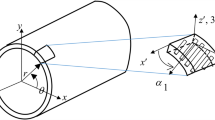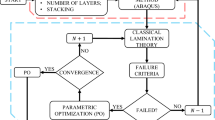Abstract
The use of composite pressure vessels particularly in the aerospace industry is escalating rapidly because of their superiority in directional strength and colossal weight advantage. The present work elucidates the procedure to optimize the lay-up for composite pressure vessel using finite element analysis and calculate the relative weight saving compared with the reference metallic pressure vessel. The determination of proper fiber orientation and laminate thickness is very important to decrease manufacturing difficulties and increase structural efficiency. In the present work different lay-up sequences for laminates including, cross-ply [0 m /90 n ] s , angle-ply [±θ] ns , [90/±θ] ns and [0/±θ] ns , are analyzed. The lay-up sequence, orientation and laminate thickness (number of layers) are optimized for three candidate composite materials S-glass/epoxy, Kevlar/epoxy and Carbon/epoxy. Finite element analysis of composite pressure vessel is performed by using commercial finite element code ANSYS and utilizing the capabilities of ANSYS Parametric Design Language and Design Optimization module to automate the process of optimization. For verification, a code is developed in MATLAB based on classical lamination theory; incorporating Tsai–Wu failure criterion for first-ply failure (FPF). The results of the MATLAB code shows its effectiveness in theoretical prediction of first-ply failure strengths of laminated composite pressure vessels and close agreement with the FEA results. The optimization results shows that for all the composite material systems considered, the angle-ply [±θ] ns is the optimum lay-up. For given fixed ply thickness the total thickness of laminate is obtained resulting in factor of safety slightly higher than two. Both Carbon/epoxy and Kevlar/Epoxy resulted in approximately same laminate thickness and considerable percentage of weight saving, but S-glass/epoxy resulted in weight increment.










Similar content being viewed by others
References
Krikanov, A.A.: Composite pressure vessels with higher stiffness. Compos. Struct. 48(1–3), 119–127 (2000)
Fukunaga, H., Chou, T.W.: Simplified design techniques for laminated cylindricalpressure vessels under stiffness and strength constraints. J. Compos. Mater 22, 1156–1169 (1988)
Grimes, G.C.: Composite Materials – Testing and design, vol. 10. ASTM Philadelphia, PA (1992). 0899–1308
Jones, R. M.: “Mechanics of Composite Materials (Materials science and engineering series)”, CRC Press; 2nd edition July, 1998, ISBN-10: 156032712X
Lekhnitskii, S.G.: In: Fern, P. (ed.) Theory of elasticity of an anisotropic elastic body. Holden-Day, Inc, San Francisco (1963)
Lekhnitskii, S.G.: In: Tsai, S.W., Cheron, T. (eds.) Anisotropic plates. Gordon and Breach, New York (1968)
Mitinskii, A.N.: The stresses in a thick-walled anisotropic tube under the influence of internal and external pressures, In: Proceedings of Institute of Engineers and Railroad Transportation in Leningrad, 1947
Belingardi, G., Genta, G., Gola, M.: Optimization of orthotropic multilayered cylinders androtating discs. AMR (J. Aerotecnica. Missili. E. Spazio.) 56(4), 204–209 (1979)
Fukunaga, H., Chou, T.-W.: Simplified design techniques for laminated cylindrical pressurevesselsunder stiffness and strength constraints. J. Comp. Mater 22, 1156–1169 (1988)
Park, J.H., Hwang J.H., Lee C.S., Hwang, W.: Stacking sequence design of composite laminates for maximum strength using genetic algorithms. Compos. Struct. 217–31 (2001)
Tauchert, T.R.: Optimum design of a reinforced cylindrical pressure vessel. J. Comp. Mater 15, 390–402 (1981)
Adali, S., Sumers, E.B., Verijenko, V.E.: Optimization of laminated cylindrical pressure vessels under strength criterion. Comp. Struct. 25, 305–312 (1993)
Reddy, J.N., Pandey, A.K.: A first-ply failure analysis of composite laminates. Comput. Struct. 25(3), 371–393 (1987)
Reddy, Y.S.N., Reddy, J.N.: Linear and non-linear failure analysis of composite laminates with transverse shear. Comput. Sci. Tech. 44, 227–255 (1992)
Oguni, K., Ravichandran, G.: A micromechanical failure model for unidirectional fiber reinforced composites. Int. J. Solids Struct. 38, 7215–7233 (2001)
Ishai, O.: Microcomputer program for analysis of mechanical behavior of multimaterial composite laminates, LIN 925 PC version, technion. Israel Institute of Technology, Haifa (1990)
S. C. Wooh and 1. M. Daniel, ICAN-Interactive Composite Analysis, Version 1.02, Northwestern University, Evanston, IL, (1992)
Barenberg, B.J.: “Effect of Interweaving on the axial compressive strength and Modulus of filament-wound composite cylinders, MIT, (1991)
Daniel, I.M., Ishai, O.: Engineering mechanics of composite materials. University Press, Oxford (1994)
Haris, H.M., Rahman H.: “Influence of Mosaic Patterns on the Structural Integrity of Filament Wound Composite Pressure Vessels”, Intl J. of Structural Integrity, Vol.2 No3, p345-356.
Mechanical APDL Advanced Analysis Techniques Guide – ANSYS Inc. November 2010. http://www1.ansys.com/customer/content/documentation/130/ans_adv.pdf
Theory Reference for the Mechanical APDL and Mechanical – ANSYS Inc. November 2010.www1.ansys.com/customer/content/documentation/120/ans_thry.pdf
Stephen, W. Tsai and H. Thomas Hahn. Introduction to Composite Materials, Section 7.2. Technomic Publishing Company. (1980)
Evans, K.E., Zhang, W.C.: The Determination of the Normal Interactive Term in the Tsai- Wu Polynomial Strength Criterion. Compos. Sci. Technol. 30, 251–262 (1987)
Ishai, O., Krishnamachari, S., Broutman, L.J.: Structural design optimization of composite laminates. Reinf. Plast. Compos. 7, 459–474 (1988)
Acknowledgements
The support from Centre of Excellence in Science & Applied Technologies (CESAT), Pakistan is acknowledged. The first author was awarded Chinese Government Scholarship from China Scholarship Council (CSC) for his MS studies and is thankfully acknowledged.
Author information
Authors and Affiliations
Corresponding author
Rights and permissions
About this article
Cite this article
Mian, H.H., Wang, G., Dar, U.A. et al. Optimization of Composite Material System and Lay-up to Achieve Minimum Weight Pressure Vessel. Appl Compos Mater 20, 873–889 (2013). https://doi.org/10.1007/s10443-012-9305-4
Received:
Accepted:
Published:
Issue Date:
DOI: https://doi.org/10.1007/s10443-012-9305-4






